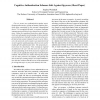26 search results - page 3 / 6 » Authenticating Pervasive Devices with Human Protocols |
HUC
2007
Springer
13 years 11 months ago
2007
Springer
Spontaneous interaction is a desirable characteristic associated with mobile and ubiquitous computing. The aim is to enable users to connect their personal devices with devices en...
MOBISYS
2010
ACM
13 years 7 months ago
2010
ACM
Ensemble is a system that uses a collection of trusted personal devices to provide proximity-based authentication in pervasive environments. Users are able to securely pair their ...
SP
2006
IEEE
13 years 11 months ago
2006
IEEE
Can we secure user authentication against eavesdropping adversaries, relying on human cognitive functions alone, unassisted by any external computational device? To accomplish thi...
TIFS
2011
13 years 5 days ago
2011
— “Pairing” is the establishment of authenticated key agreement between two devices over a wireless channel. Such devices are ad hoc in nature as they lack any common preshar...
MIDDLEWARE
2005
Springer
13 years 10 months ago
2005
Springer
The vision of pervasive or ubiquitous computing, conceived by Mark Weiser, foresees a world where computing is embedded in every day objects. Such objects interact with each other...

